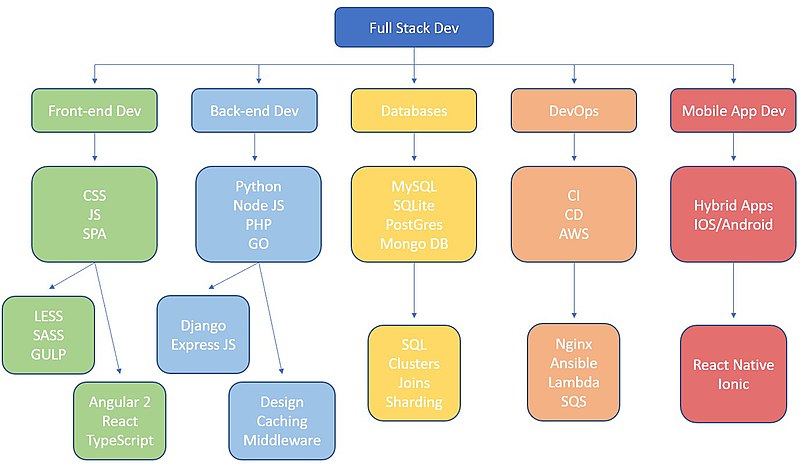The job market constantly evolves, but rest assured, pursuing a career in development is a wise decision. Full-stack developers are in exceptionally high demand, and their skillset is increasingly indispensable.
Keep reading this article as we delve into the essence of full-stack development, unequivocally demonstrating why it is an outstanding career choice. Prepare to discover the remarkable potential for growth and development within this field.
What is Full Stack Development?
Full stack development encompasses the entire spectrum of application software creation, encompassing both the front-end and back-end components. The front end pertains to the user interface, while the back end manages the business logic and application workflows.
What languages do full-stack developers use?
Full-stack developers can select a compatible set of languages for their projects within the application framework. JavaScript, in particular, enjoys significant popularity among full-stack developers due to its unique versatility, being suitable for both front-end and back-end development. Companies often seek full-stack developers for more minor to medium-sized projects. Here are some popular languages in each category:
- Front end: HTML, CSS, JavaScript
- Back end: Python, Java, R, Ruby, Node.js, PHP
Java remains a top preference among full-stack developers and maintains its high demand in the tech market.
How to Become a Java Full-Stack Developer?
A Java full-stack developer utilizes the popular Java programming language in web development. Web applications typically comprise three layers: the front end, the back end, and the database layer. These experts are proficient in coding for all these layers. Users interact with the application through the front end, which displays elements during their interaction. Java full-stack development projects encompass data handling for visible application components, with the database layer serving as storage and retrieval for data from other application layers.
The introduction of Java Full Stack course allows learners to master advanced coding techniques for both front-end and back-end software development.
Skills Required for Java Full Stack Developer
Enrolling in a Java Full Stack course can help you build the knowledge and skills required for a successful career in the fast-growing IT industry. In your journey to become a full-stack Java developer, you’ll discover the need to excel in a range of essential skills, with the most crucial ones outlined below.
- CSS and HTML
- JavaScript
- NodeJS and Python
- Web Storage and Databases
- Sourcetree, GitHub, and Git
- REST and HTTP
- Design for the Web
The future outlook for full-stack developers involves continuous learning of novel tools and technologies. With new solutions and innovations emerging constantly, addressing challenges, and generating new products and services, the distinction between a proficient software engineer and an exceptional one lies in their capacity to acquire new languages and frameworks swiftly.
Full Stack Developer: Roles and Responsibilities
As a full-stack developer, your role involves independently developing comprehensive applications without needing assistance from other team members. Proficiency in building large-scale applications from scratch is essential for this purpose.
Responsibilities of a Full Stack Developer:
- Craft interactive user interfaces using a variety of front-end technologies
- Design a robust back-end architecture, utilizing diverse technologies to retrieve data from servers
- Establish databases and servers that maintain continuous operation and resilience against disruptions
- Ensure cross-platform compatibility, allowing your applications to function on different devices
- Develop APIs tailored to the specific application being created
- Create adaptable applications that meet the evolving needs and expectations of consumers
Full Stack Developer: Salary
According to Ambition Box, the average annual salary of a full stack developer in India ranges approximately between ₹ 1.8 Lakhs to ₹ 16.0 Lakhs. In 2023, the average annual salary for a full-stack developer is ₹8,10,433.
Job roles in Full Stack Development
Full-stack developers possess front-end and back-end web development expertise, opening doors to diverse job roles. Here are some significant job opportunities available to Java full-stack developers:
- Full Stack Software Engineer
- Java Software Developer
- Java Full Stack Software Engineer
- Full Stack Engineer
- Frontend Developer
- Backend Developer (Java)
Future Scope of Full Stack Development
A full-stack developer is akin to a versatile chef who prepares the entire feast, not just a single dish. This professional possesses a diverse skill set, from backend development to frontend and mobile app development. While full-stack developers can proficiently work with multiple programming languages, they often possess specialized expertise in specific domains.
The demand for full-stack developers is expanding. Historically, developers were assigned to specific technologies or projects, concentrating solely on their designated tasks. Today, full-stack developers are anticipated to handle multiple technologies concurrently, seamlessly transitioning between them to enhance efficiency.
Furthermore, excellent communication skills are now a vital asset for full-stack developers. They frequently collaborate with diverse teams and departments beyond development, necessitating clear and efficient communication across varying backgrounds and disciplines.
Conclusion:
A full-stack developer represents a pivotal resource for companies striving for enhanced success in the technology industry. Given the swift progress in software and technology, the scope for full-stack developers is poised for substantial growth in the future. Optimize your full-stack developer career and educational journey for effectiveness, and explore the Java Full Stack Developer Course that offers practical learning experiences and exposure to resume-enhancing live projects.
